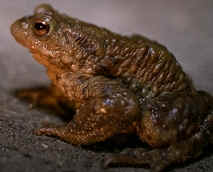Amphibians

Common Toad
Toad
Common Frog Palmate Newt Smooth Newt
Great
Crested Newt
Tadpole to Frog - Frog Life Cycle in Pictures!
Amphibians are vertebrate (i.e. with backbones) animals belonging to the Class Amphibia. This includes frogs, toads, newts and salamanders. Amphibians are cold-blooded. This means that their body temperature varies with the surrounding air or water temperature and does not remain constant as in warm-blooded animals. Amphibians can live for much of their adult life out of water. Nearly all amphibians and all British species, have to return to water to breed. This is because the eggs lack a hard protective shell and must be kept moist in water. In early spring the adults congregate in freshwater ponds and lakes. Typically the female lays the eggs in the water which are then fertilised by a male. This is known as external fertilisation. Huge numbers of eggs are usually laid because the tadpoles which hatch out of the eggs, are eaten by inumerable other species and their mortality rates are very high. Toad and frog tadpoles are initially herbivorous, later becoming carnivores. All amphibians undergo a physical transformation known as metamorphosis in which the tadpoles gradually acquire legs and adult characteristics. In some amphibians, such as frogs and toads, the tadpole's tail is eventually lost by being absorbed into the body. The external gills which are common to all amphibian tadpoles are also lost. Adult amphibians spend much of their life out of water living in and around damp and moist areas. They eat slugs, worms and small invertebrates. In Britain and throughout the world amphibians are in decline. Whilst all the reasons for this are not known, habitat loss is without doubt a major cause. In Britain 75% of ponds have been lost in just 50 years. Of those that remain, few are capable of supporting the necessary numbers of adults which is required to preserve genetic diversity. As a result inbreeding occurs. In the U.K all native amphibians are afforded some protection under the Wildlife and Countryside Act 1981.
|
| Common Name | Latin Name |
| Toad | Bufo bufo |
| Common Frog | Rana temporaria |
| Palmate Newt | Triturus helveticus |
| Smooth Newt | Tritus vulgaris |
| Great Crested | Tritus cristatus |
Learn lots more about
British Newts!
Distribution
Conservation
Species
Reproduction
Only those species with a
dedicated page are listed below. Use Search
to find listings for dozens of other species on this website.
Other links Froglog